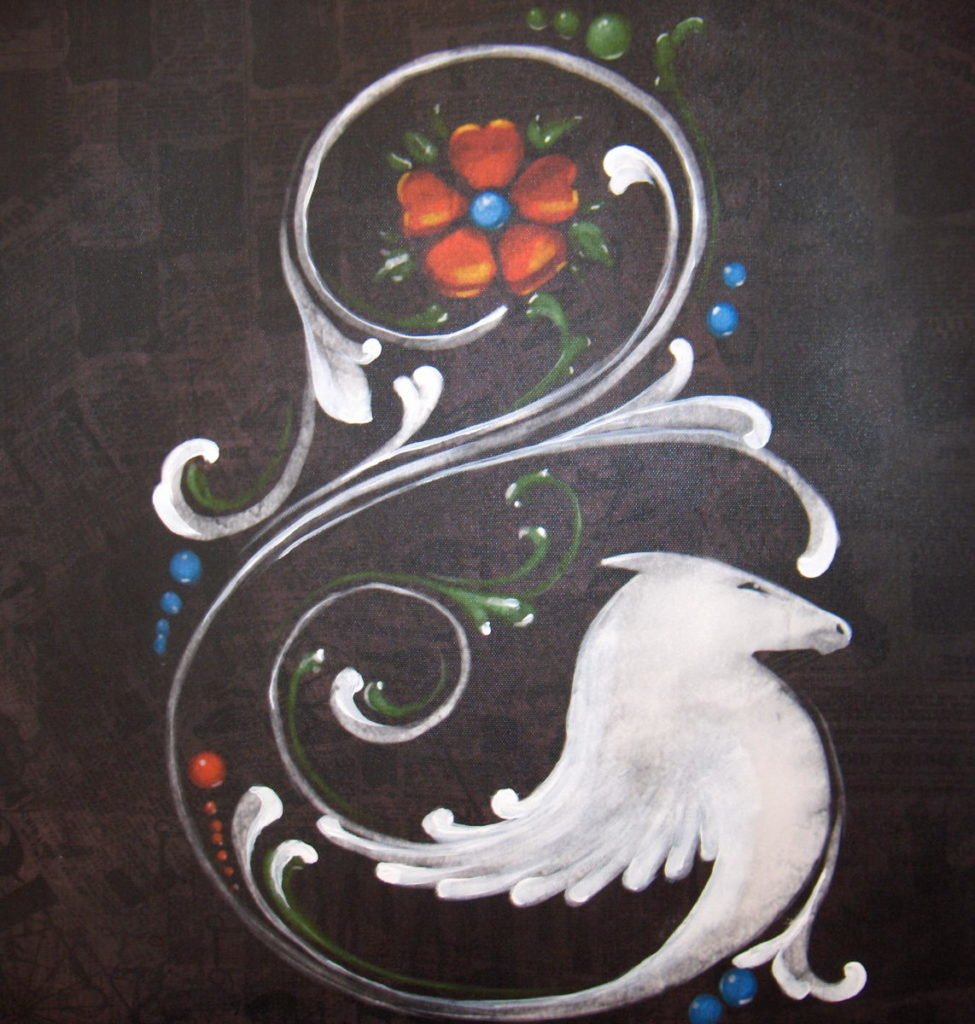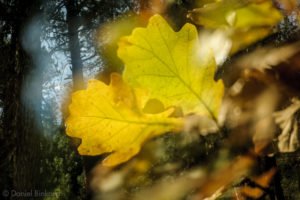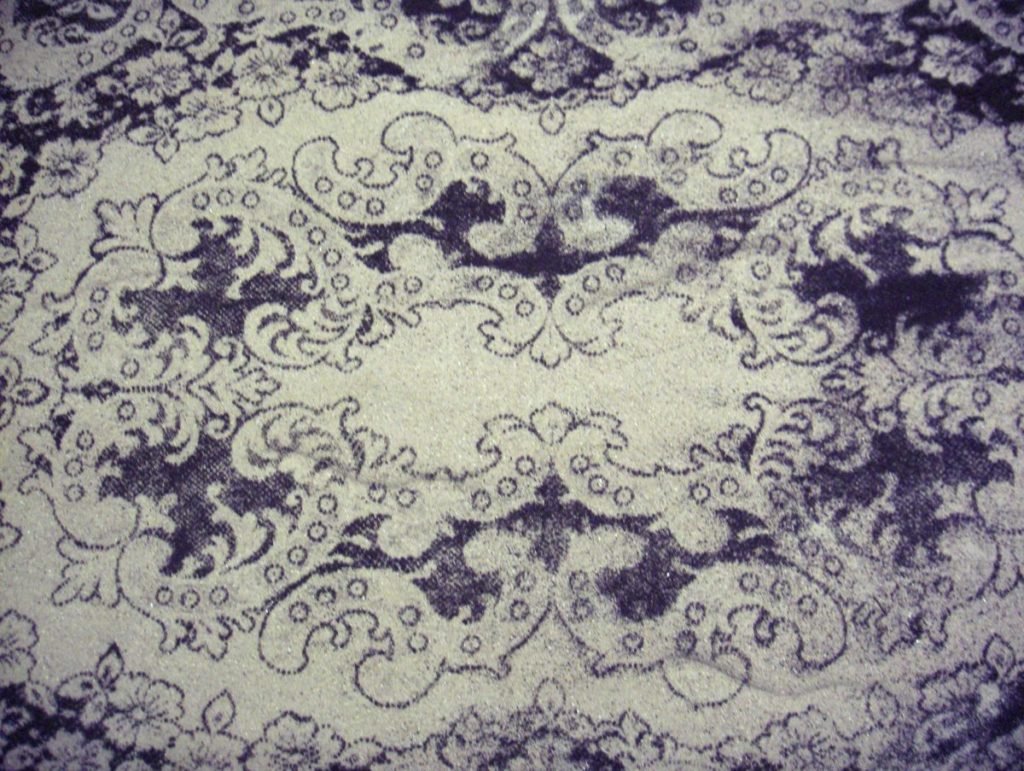If a piece of artwork could express itself in words, what would it say? This was the question I pondered while visiting Time Lapse, an art faculty show at Chadron State College (CSC) in Chadron, Nebraska several semesters ago.
Here’s the beginning of what Black and White Crease, a painting by adjunct faculty member, DeWayne Gimeson, seemed to say to me: I believe in creases like the ones that form on balls of paper we too often throw away. We rarely see their peaks, their crevices, their unscripted shadows save for the quiet exhale—the curious ridge arcing, a wrinkle rethinking itself. I am a labyrinth, a map of openings and cryptic paths.
Another, Dirt Rug, by Assistant Professor Trudy Denham, spoke to me in this way: I am a dirt rug but fairly clean and rich-looking…for now. Notice the footprint that thought me a mat. There will be more. There always are at these shows. They level my prospects and jostle my scope. They kick me while I’m down without even knowing it. After a while, it will be hard for me to hold my own. When someone kneels to straighten me out, their fingers will sift dirt and sand, unable to grasp my fragility, my sublime lowliness.

And so it went throughout my tour of the several dozen pieces of artwork on display. I imagined each work an essay and by the time I studied adjunct faculty member Carly Heath’s White Horse Rosemaling, an idea for a writing project for my students materialized. I wondered, what essays and stories would Time Lapse tell them? Would they hear the words I heard that spilled from this exquisite work? I am the horse without a universe. Dare ride me to worlds unimagined. Would they take the ride?
***
One of the courses I taught that semester was Matters of Opinion, a first-year inquiry course designed to help students develop critical and creative thinking skills to ultimately shape well-informed opinions. Learning activities included lectures, group discussions, guest speakers, and essay-writing. Little did I know that I would add one more activity to the mix: a trip to an art show.
The night we met inside the foyer of the Main Gallery at Memorial Hall, I asked the students to imagine each of the pieces in the art show to be an artistic essay and to select one that “spoke” to them. I then passed out work sheets with the following questions:
- What about the artwork you’ve chosen to study caught your attention?
- What does the artist believe in and why does she/he believe it?
- What specifically about the artwork best explains his/her belief? How?
- If the piece of artwork you are considering could express itself in words, write the first paragraph. In other words, if the artwork were asked to write an essay, what would it say?
***
Inside the gallery, it was as if there were a mishmash of magnetic fields, the twenty-five students pulled in many directions. The works of Daniel Binkard, Digital Graphic Designer, attracted Tindra. who stood in a spellbound state taking copious notes of the artist’s clear and cloudy autumnal images. In his Artist Statement, Mr. Binkard wrote, “I am interested in the contrast between sharpness and unsharpness, along with the uncertainty inherent in creating these compositions in-camera.”
As I stood near Tindra examining the photographs of leaves, branches, and wildflowers, I was struck by the artist’s notions on nature, its degrees of clarity and ambiguity, its split-personality. At one moment there seemed a need for binoculars, then not.
A few days later, I read Tindra’s reactions: “The artist believes that life is complex and it can cause you to feel dazed but, even then, life is beautiful. The artist’s works exemplifies this belief through his out-of-focus photographs.”

In imagining the work expressing itself in words, Tindra wrote: “I believe that life is beautiful, even when parts of it do not make sense. Each step, each moment, and each decision are not always clear at the time it occurs. When life leaves me dazed and out of sorts, I believe it is necessary to take a moment and step back. I believe that the bigger picture of life is something beautiful, whether crystal clear or fuzzy around the edges.”
***
According to Professor Mary Donahue, the name of the art faculty show, Time Lapse, evolved from a planning session. In an interview with Tena Cook, Chadron State College Marketing Coordinator, she said, “Time lapse photography was mentioned. It seemed the idea of time and the idea of lapse were interesting concepts and relevant to what all of us might be doing with our art in one way or another whether it be installations that are temporary, landscape imagery that captures and instant of light and color, a frozen moment of clouds and sky or branches and leaves, the vagueness of imagery floating in an undefined space, or the movement of light itself.”
***
Kayla was staring deeply into Nebraska Pine Ridges: Beaver Wall, one of Professor Donahue’s oil paintings, when I joined her. “I can already tell you what drew me to this piece,” she said. “It’s the flow of the colors and the relationship between the sky, land, and rocks. I’ve been standing here for fifteen minutes and I’ve looked at every little part of the canvas.”
I could see what she meant by “flow of colors.” They were beautifully tinged in soft shades of coral, pink, and sandstone. It’s a majestic scene I’ve witnessed many times traveling the Nebraska panhandle. The colors magically reflect themselves in drifting clouds with hints of peach or cappuccino.
Before I could verbalize these thoughts, Kayla said, “This artist believes that nature has beauty, that nature is full of color, whether you can see it or not. Some colors may not be as realistic but that’s what she sees in her creative mind.”
As she spoke, Kayla kept her eyes riveted on the painting, almost oblivious to my presence. I realized that by first speaking what she saw helped her to organize her ideas before writing them down. Continuing to focus on the artwork, she said, “The land and the hills, though exaggerated, are what best explains her belief. She provides insights of what nature is like from how she sees things, including color.”
When I read Kayla’s opening essay sentences several days later, she wrote, “I believe in the unity of sky, land, and rocks. On a canvas, the three become as one and they make something beautiful. Earth.”
***
On the east side of the exhibit, I noticed several students gathered around a piece I could not quite see. As I approached the group, I realized it was Mr. Gimeson’s Black & White Crease painting I had seen several days earlier.
In his Artist Statement, he described photographs as “records of time.” He went onto say, “As a photographer, I have been intrigued with the idea of capturing time in an image whether that time-capture is for a thousandth of a second or light painting for several minutes. The thousandth of a second freezes that moment, capturing an instant of life.”
Two of the students were talking about the piece as “crinkled paper.” I jotted down some of their comments:
“I think that if this painting could talk, it would say that everyone is like crinkled paper,” Cameron said. “No one is without flaws. We’re a lot more alike than different.”
“The artist believes that the creased and crinkled paper still has value,” Miles added. “This goes for people, too. No matter how someone may look to you, you do not fully understand them or what they are capable of. No matter how someone looks, they, too, have value.”
Jazmin, who had been listening to the discussion, offered a different take. “I feel like the artist believes that life isn’t just a blank piece of paper. It has creases as you move through life. You have good moments and bad. Life isn’t perfect, just like the paper. It’s a journey with many different paths. There are no directions—you have to come up with them.”
Another student, Rachel, stood about thirty feet from Mr. Gimeson’s work. After taking notes, she moved closer. She repeated this process several times. She would later write: “If this painting could express itself, it would tell us that it believes in the power of illusion. Far away, I saw a crumpled piece of paper but as I drew closer, I could tell it was so much more. What something looks like from afar can look completely different close up. Distance from an object causes much uncertainty. Is it safe to come close? Do I take the risk? Illusion is risk.”
***
As I made my way toward the color photograph collection of Professor Laura Bentz, I met Paige who was still searching for artwork that resonated with her. When we drew closer to the wall exhibit, Paige’s eyes widened. “I think I may have found it.”
Professor Bentz’s Artist Statement read: “Across the road from the house where I live there is a large, open field. The sky over the field is, at times, vacant. Other times, it is cloud-filled. Looking out at that field, there is a perception of stillness, a sense that nothing momentous ever occurs. Yet, it is when the sun is low to the horizon and the light skims across the land and sky, a transformation can be witnessed. Colors and textures no longer belong to the realm of ‘field’ or ‘sky’ but the ephemeral. The color photographs in this exhibition are my attempt to distill these transitory events in the field across the road, the sky, and other similar vistas.”
Paige selected a piece entitled, North, South, East, and West. She had this to say in her writing: “From the looks of the pictures, the artist believes that perspective is everything. She wants people to look at things from multiple angles to make sure they’re getting the full story. The artist stood in the same spot and took photographs in four different directions, at different times of day. Each picture is labeled north, south, east or west. Without the labels, you would think the pictures were at different locations. They are different perspectives.”
In writing about the photograph expressing itself, she asked, “Think if you were on top of a mountain—would you stare into one direction or would you look around and take it all in? Perspective is key in today’s society.”
I was staring at Professor Bentz’s photograph, Toadstool, when Paige moved on and Ed arrived. I was taken by the crisscrossing clouds above a lengthy rock formation that, from a distance, reminded me of Camelback Mountain in Phoenix, Arizona—except this creature was not a camel. It was much lower to the ground, like a feral cat catching a nap, confident the clouds had its back. There was something very serene about it.
“It’s very relaxing,” Ed said, breaking the silence. “What I like about it is that there is no interference from any manmade objects. It’s just calm and gorgeous.”
Ed later wrote: “What this piece would say is that I believe there is too much manmade interference in our lives. We all have to take a step back and enjoy what we are given; we need to take a deep breath. Everyone is always in a hurry. Sometimes, having nothing interfere with you is a good thing. You see and notice things you did not before.”
***

Crouching near Assistant Professor Denham’s Rug series of dirt and sand, Dominic carefully scanned one of the intricate carpets like a professional surveyor. He frequently shifted positions to take in the work from all angles. It was part of the creative collection I had seen during my previous visit. I noticed several more footprints and commented that perhaps the artist should have put up barriers to prevent people from stepping on the pieces.
“Or, she did not do so deliberately,” he said. “The fine detail of the exhibit can easily be overlooked by visitors as they take the first step onto the exhibit and then step away. The fact that so much time must have gone into the making of the rugs, but still no barriers were erected around them, is a stake in the heart, affirming this belief that people can so easily ruin others’ work.”
Dominic explained, “The artist seems to provide the insight that no matter how hard you work in life, and no matter how intricate that work is, it will always be impacted by others. Humanity will always be clumsy and reckless, possibly harming or leaving irreversible impacts on nature.”
Enticed by his rationale, I looked forward to reading his imaginative writing about the work disclosing its belief. He eventually wrote: “Humanity will inevitably affect nature. You can try your hardest to take only pictures and leave only footprints, but those footprints still greatly affect the surrounding beauty that nature has tried to keep pristine.”
***
As our visit was coming to a close, I noticed Terra kneeling on the floor writing in her notebook several feet away from Ms. Heath’s collage of horses. When she saw me, she said, “It looks like the horse is coming out of the flowers, as if it couldn’t exist without them.”
She was right. When I had seen it earlier, I saw more of a solar system than flowers. On first glance I had seen planets instead of the lush blossoms.
Pointing, she said, “See? The flowers flow off the horse. The horse has no body and no limbs. In the place of its body and limbs are flowers.” She paused in wonderment; I relished the moment.
“The horse is incomplete without them. The horse is different from the flowers but they are also the same. I absolutely love the colors.”
Terra and her classmates were taking the ride.
***
Before turning out the lights in the gallery, I noticed one other display consisting of yarn squares neatly placed on a marble pedestal. It was the work of Ms. Sarah Polak, former director of the college’s Mari Sandoz Center, who wrote in her Artist Statement, “For the works in this show, I was inspired by the lusciousness of the colors in the fibers. Each square is made from 7.5-8 yards of yarn and was created on a 4”x4” square loom.”
In examining her hypnotic weave work, I wondered how I had overlooked this gracious exhibit of elegant threading. In a way, it seemed a befitting final curtain for the evening’s art walk. In a few days, I would read each of the essays. Upon completion, I reflected back to the enchanting squares: “Like Ms. Polak’s delicately-pieced Nine-Patch Study in Blue, the artwork and essays blended beautifully together—enduring fibers of thought in many shades, many perspectives.”
***
It should be noted that there were whispers and wisecracks when we first gathered in the lobby outside Memorial Hall’s Main Art Gallery. Scattered frowns and looks of indifference from several students near the exit doors had me second-guessing what I originally thought was an enterprising plan. Was my imaginative writing journey more a misadventure of wasted time? Was this the silly dream of an eccentric professor? As they filed into the dimly-lit chamber of artistry, however, my worries began to fade. So did the smirks. Mockery was replaced with marvel, razz with respect. The imaginative writing, so to speak, was on the wall and the possibilities painted themselves.
So, what happened? The students became the creases, horse flowers, and helpless sand mats. They found their ways into moments—those tiny and sacred spaces without Wi-Fi for Facebook or Twitter. They found the silent comfort that comes when writing makes learning one’s own.
Empowering students with opportunities to freelance their thoughts and ideas is a big step in the creative process. Providing them with choices changes the way they view learning. In writing, their words claim the moment.
I have learned that I need to take my students to more art shows and exhibits. My new mantra has become: Bring them to an art show. Of course, imaginative writing goes well beyond expos and galleries—for life, and everything around us, is an art show.
They should see the tilts of umbrellas during a rainstorm, the last runners joining hands at a finish line, a bridge, a wall, the out-of-focus looks in people’s eyes.
They should see the faces of elders who can hardly wait for daybreak to coffee with friends and those of bleary-eyed children, still half-asleep, frightened by gunshots in the night.
They should look for bird clouds shaking bed sheets and weather vanes telling time to the wind. They should see the colors of content, the shapes of struggle, and treasures wedged inside a sidewalk crack.
***
Skimming light, a crumpled piece of paper, an unclear leaf clinging to a stick-thin branch, time freezing, a carpet losing its identity, stillness, illusion…evidence of the importance of teaching imaginative writing.

Share this post with your friends.


This was a thought-provoking article and delightful to know that such a wonderful and insightful person is teaching our leaders of tomorrow to not only appreciate life but to thoughtfully reflect on it. It was brilliant that he used art to bring them into the moment and help them not only perceive it but reflect on it and express their feelings about it, ultimately allowing them to perceive something about themselves. Thank you so much for sharing this insightful piece.
Thank you, Jeanne, for taking the time to respond to my essay. I appreciate your kind words. They mean a lot coming from you, a gifted and dedicated teacher who I have always admired.
Have you ever thought about creating an ebook or guest authoring
on other sites? I have a blog based on the same subjects you discuss and would really
like to have you share some stories/information. I know my viewers
would value your work. If you’re even remotely interested,
feel free to send me an e mail.